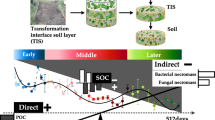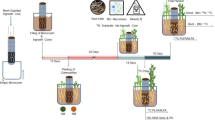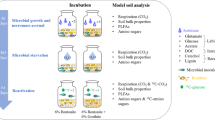Abstract
Microorganisms regulate soil organic matter (SOM) formation through accumulation and decomposition of microbial necromass, which is directly and indirectly affected by elevated CO2 and N fertilization. We investigated the role of microorganisms in SOM formation by analyzing 13C recovery in microorganisms and carbon pools in paddy soil under two CO2 levels, with and without N fertilization, after continuous 13CO2 labelling was stopped. Microbial turnover transferred 13C from living microbial biomass (determined by the decrease in phospholipid fatty acids) to necromass (determined by the increase in amino sugars). 13C incorporation in fungal living biomass and necromass was higher than that in bacteria. Bacterial turnover was faster than necromass decomposition, resulting in net necromass accumulation over time; fungal necromass remained stable. Elevated CO2 and N fertilization increased the net accumulation of bacterial, but not fungal, necromass. CO2 levels, but not N fertilization, significantly affected 13C incorporation in SOM pools. Elevated CO2 increased 13C in particulate organic matter via the roots, and in the mineral-associated organic matter (MAOM) via bacterial, but not fungal, necromass. Overall, bacterial necromass plays a dominant role in the MAOM formation response to elevated CO2 because bacteria are sensitive to elevated CO2.






Similar content being viewed by others
References
Anderson TH, Joergensen RG (1997) Relationship between SIR and FE estimates of microbial biomass carbon in deciduous forest soils at different pH. Soil Biol Biochem 29:1033–1042
Bååth E (1994) Thymidine and leucine incorporation in soil bacteria with different cell-size. Microbial Ecol 27:267–278
Bicharanloo B, Bagheri SM, Keitel C, Dijkstra FA (2020) Rhizodeposition mediates the effect of nitrogen and phosphorous availability on microbial carbon use efficiency and turnover rate. Soil Biol Biochem 142:107705
Bolan NS, Baskaran S, Thiagarajan S (1996) An evaluation of the methods of measurement of dissolved organic carbon in soils, manures, sludges, and stream water. Commun Soil Sci Plant Anal 27:2723–2737
Bossio DA, Scow KM, Gunapala N, Graham KJ (1998) Determinants of soil microbial communities: effects of agricultural management, season, and soil type on phospholipid fatty acid profiles. Microb Ecol 36:1–12
Brookes PC, Powlson DS, Jenkinson DS (1984) Phosphorus in the soil microbial biomass. Soil Biol Biochem 16:169–175
Cheng W, Parton WJ, Gonzalez-Meler MA, Phillips R, Asao S, Mcnickle GG, Brzostek E, Jastrow JD (2014) Synthesis and modeling perspectives of rhizosphere priming. New Phytol 201:31–44
Cotrufo MF, Wallenstein MD, Boot CM, Denef K, Paul E (2013) The Microbial Efficiency-Matrix Stabilization (MEMS) framework integrates plant litter decomposition with soil organic matter stabilization: Do labile plant inputs form stable soil organic matter? Glob Chang Biol 19:988–995
de Boer W, Folman LB, Summerbell RC, Boddy L (2005) Living in a fungal world: impact of fungi on soil bacterial niche development. FEMS Microbiol Rev 29:795–811
Dijkstra FA, Augustine DJ, Brewer P, von Fischer JC (2012) Nitrogen cycling and water pulses in semiarid grasslands: are microbial and plant processes temporally asynchronous? Oecologia 170:799–808
Dorodnikov M, Blagodatskaya E, Blagodatsky S, Fangmeier A, Kuzyakov Y (2009) Stimulation of r- vs. K-selected microorganisms by elevated atmospheric CO2 depends on soil aggregate size: Research article. FEMS Microbiol Ecol 69:43–52
Engelking B, Flessa H, Joergensen RG (2007) Shifts in amino sugar and ergosterol contents after addition of sucrose and cellu- lose to soil. Soil Biol Biochem 39:2111–2118
Esperschütz J, Gattinger A, Buegger F (2009) A continuous labelling approach to recover photosynthetically fixed carbon in plant tissue and rhizosphere organisms of young beech trees (Fagus sylvatica L.) using 13C depleted CO2. Plant Soil 323:21–29
Evans RD, Koyama A, Sonderegger DL, Charlet TN, Newingham BA, Fenstermaker LF, Harlow B, Jin VL, Ogle K, Smith SD (2014) Greater ecosystem carbon in the Mojave Desert after ten years exposure to elevated CO2. Nat Clim Chang 4:394–397
Frostegård A, Bååth E (1996) The use of phospholipid fatty acid analysis to estimate bacterial and fungal biomass in soil. Biol Fert Soils 22:59–65
Frostegård A, Tunlid A, Bååth E (2011) Use and misuse of PLFA measurements in soils. Soil Biol Biochem 43:1621–1625
Ge T, Li B, Zhu Z, Hu Y, Yuan H, Dorodnikov M, Jones DL, Wu J, Kuzyakov Y (2017) Rice rhizodeposition and its utilization by microbial groups depends on N fertilization. Biol Fertil Soils 53:37–48
Gregorich E, Beare M, McKim U, Skjemstad J (2006) Chemical and biological characteristics of physically uncomplexed organic matter. Soil Sci Soc Am J 70:975–985
Grover M, Maheswari M, Desai S, Gopinath KA, Venkateswarlu B (2015) Elevated CO2: Plant associated microorganisms and carbon sequestration. Appl Soil Ecol 95:73–85
Gunina A, Kuzyakov Y (2014) Pathways of litter C by formation of aggregates and SOM density fractions: Implications from 13C natural abundance. Soil Biol Biochem 71:95–104
Gunina A, Kuzyakov Y (2022) From energy to (soil organic) matter. Glob Chang Biol 28:2169–2182
Gunina A, Dippold M, Glaser B, Kuzyakov Y (2017) Turnover of microbial groups and cell components in soil:13C analysis of cellular biomarkers. Biogeosciences 14:271–283
Hu Z, Chen X, Yao J, Zhu C, Zhu J, Liu M (2020) Plant-mediated effects of elevated CO2 and rice cultivars on soil carbon dynamics in a paddy soil. New Phytol 225:2368–2379
Intergovernmental Panel on Climate Change (IPCC) (2014) Climate change 2014: synthesis report. In: Core writing team, Pachauri RK, Meyer LA (eds) Contribution of working groups I, II and III to the fifth assessment report of the intergovernmental Panel on climate change. Cambridge University Press, Cambridge, p 74
Iversen CM, Keller JK, Garten CT, Norby RJ (2012) Soil carbon and nitrogen cycling and storage throughout the soil profile in a sweetgum plantation after 11 years of CO2-enrichment. Glob Chang Biol 18:1684–1697
Jenkinson DS, Brookes PC, Powlson DS (2004) Measuring soil microbial biomass. Soil Biol Biochem 36:5–7
Joergensen RG (2018) Amino sugars as specific indices for fungal and bacterial residues in soil. Biol Fertil Soils 54:559–568
Joergensen RG (2022) Phospholipid fatty acids in soil—drawbacks and future prospects. Biol Fertil Soils 58:1–6
Joergensen RG, Wichern F (2008) Quantitative assessment of the fungal contribution to microbial tissue in soil. Soil Biol Biochem 40:2977–2991
Jones DL, Nguyen C, Finlay RD (2009) Carbon flow in the rhizosphere: carbon trading at the soil–root interface. Plant Soil 321:5–33
Kaiser C, Frank A, Wild B (2010) Negligible contribution from roots to soil-borne phospholipid fatty acid fungal biomarkers 18:2omega6,9 and 18:1omega9. Soil Biol Biochem 42:1650–1652
Kallenbach CM, Frey SD, Grandy AS (2016) Direct evidence for microbial-derived soil organic matter formation and its ecophysiological controls. Nat Commun 7:1–10
Kindler R, Miltner A, Richnow H-H, Kästner M (2006) Fate of gram-negative bacterial biomass in soil—mineralization and contribution to SOM. Soil Biol Biochem 38:2860–2870
Kuzyakov Y, Horwath WR, Dorodnikov M, Blagodatskaya E (2019) Review and synthesis of the effects of elevated atmospheric CO2 on soil processes: No changes in pools, but increased fluxes and accelerated cycles. Soil Biol Biochem 128:66–78
Li Y, Shahbaz M, Zhu Z, Deng Y, Tong Y, Chen L, Wu J, Ge T (2021) Oxygen availability determines key regulators in soil organic carbon mineralisation in paddy soils. Soil Biol Biochem 153:108106
Li Y, Yuan H, Chen A, Xiao M, Deng Y, Ye R, Zhu Z, Inubushi K, Wu J, Ge T (2022a) Legacy effect of elevated CO2 and N fertilization on mineralization and retention of rice (Oryza sativa L.) rhizodeposit-C in paddy soil aggregates. Soil Ecol Lett 4:78–91
Li Y, Zhu Z, Wei X, Kuzyakov Y, Li B, Kim PJ, Wu J, Liu S, Ge T (2022b) Sources and intensity of CH4 production in paddy soils depend on iron oxides and microbial biomass. Biol Fertil Soils 58:181–191
Liang C, Amelung W, Lehmann J, Kästner M (2019) Quantitative assessment of microbial necromass contribution to soil organic matter. Glob Chang Biol 25:3578–3590
Liu Z, Liu X, Wu X, Bian R, Liu X, Zheng J (2021) Long-term elevated CO2 and warming enhance microbial necromass carbon accumulation in a paddy soil. Biol Fertil Soils 57:673–684
Liu Y, Ge T, Wang P, Jan van Groenigen K, Xu X, Cheng K, Zhu Z, Wang J, Guggenberger G, Chen J, Luo Y, Kuzyakov Y (2023) Residence time of carbon in paddy soils. J Clean Prod 400:136707
Luo Y, Xiao M, Yuan H, Liang C, Zhu Z, Xu J, Kuzyakov Y, Wu J, Ge T, Tang C (2021) Rice rhizodeposition promotes the build-up of organic carbon in soil via fungal necromass. Soil Biol Biochem 160:108345
Malik AA, Chowdhury S, Schlager V, Oliver A, Puissant J, Vazquez PGM, Jehmlich N, von Bergen M, Griffiths RI, Gleixner G (2016) Soil fungal: Bacterial ratios are linked to altered carbon cycling. Front Microbiol 7:1–11
Miltner A, Bombach P, Schmidt-Brücken B, Kästner M (2012) SOM genesis: Microbial biomass as a significant source. Biogeochemistry 111:41–55
Mulvaney RL (1996) Nitrogen – Inorganic forms. In: Sparks DL, Page AL, Helmke PA, Loeppert RH, Soltanpour PN, Tabatabai MA, Johnston CT, Sumner ME (eds) Methods of soil analysis. Part.3. Chemical methods. Soil Science Society of America, Book Series, Madison, WI, pp 1123–1184. https://doi.org/10.2136/sssabookser5.3.c38
Murphy J, Riley JP (1962) A modified single solution method for the determination of phosphate in natural waters. Anal Chim Acta 27:31–36
Pendall E, Mosier AR, Morgan JA (2004) Rhizodeposition stimulated by elevated CO2 in a semiarid grassland. New Phytol 162:447–458
Samson ME, Chantigny MH, Vanasse A, Menasseri-Aubry S, Royer I, Angers DA (2020) Management practices differently affect particulate and mineral-associated organic matter and their precursors in arable soils. Soil Biol Biochem 148:107867
Schweigert M, Herrmann S, Miltner A, Fester T, Kästner M (2015) Fate of ectomycorrhizal fungal biomass in a soil bioreactor system and its contribution to soil organic matter formation. Soil Biol Biochem 88:120–127
Seifert A-G, Trumbore S, Xu X, Zhang D, Gleixner G (2013) Variable effects of plant colonization on black slate uptake into microbial PLFAs. Geochim Cosmochim Acta 106:391–403
Simpson RT, Frey SD, Six J, Thiet RK (2004) Preferential accumulation of microbial carbon in aggregate structures of no-tillage soils. Soil Sci Soc Am J 68:1249–1255
Six J, Frey S, Thiet R, Batten K (2006) Bacterial and fungal contributions to carbon sequestration in agroecosystems. Soil Sci Soc Am J 70:555–569
Sparling GP (1992) Ratio of microbial biomass carbon to soil organic carbon as a sensitive indicator of changes in soil organic matter. Aust J Soil Res 30:195–207
Strickland MS, Rousk J (2010) Considering fungal: bacterial dominance in soils-methods, controls, and ecosystem implications. Soil Biol Biochem 42:1385–1395
Treseder KK, Allen MF (2000) Mycorrhizal fungi have a potential role in soil carbon storage under elevated CO2 and nitrogen deposition. New Phytol 147:189–200
Veloso MG, Angers DA, Chantigny MH, Bayer C (2020) Carbon accumulation and aggregation are mediated by fungi in a subtropical soil under conservation agriculture. Geoderma 363:114159
Wang B, An SS, Chao L, Liu Y, Kuzyakov Y (2021) Microbial necromass as a source of organic carbon in global ecosystems. Soil Biol Biochem 162:108422
Wei L, Ge T, Zhu Z, Ye R, Penuelas J, Li Y, Lynn TM, Jones DL, Wu J, Kuzyakov Y (2022a) Paddy soils have a much higher microbial biomass content than upland soils: A review of the origin, mechanisms, and drivers. Agric Ecosyst Environ 326:107798
Wei L, Zhu Z, Razavi BS, Xiao M, Dorodnikov M, Fan L, Yuan H, Yurtaev A, Luo Y, Cheng W, Kuzyakov Y, Wu J, Ge T (2022b) Visualization and quantification of carbon “rusty sink” by rice root iron plaque: Mechanisms, functions, and global implications. Glob Chang Biol 28:6711–6727
Wu J, Joergensen RG, Pommerening B, Chaussod R, Brookes PC (1990) Measurement of soil microbial biomass C by fumigation-extraction: an automated procedure. Soil Biol Biochem 22:1167–1169
Wu J, Zhou P, Li L, Su Y, Yuan H, Syers JK (2012) Restricted mineralization of fresh organic materials incorporated into a subtropical paddy soil. J Sci Food Agric 92:1031–1037
Xia Y, Chen X, Hu Y, Zheng S, Ning Z, Guggenberger G, He H, Wu J, Su Y (2019) Contrasting contribution of fungal and bacterial residues to organic carbon accumulation in paddy soils across eastern China. Biol Fertil Soils 55:767–776
Xiao M, Zang H, Liu S, Ye R, Zhu Z, Su Y, Wu J, Ge T (2019) Nitrogen fertilization alters the distribution and fates of photosynthesized carbon in rice–soil systems: a 13C-CO2 pulse labeling study. Plant Soil 445:101–112
Yang Y, Xie H, Mao Z, Bao X, He H, Zhang X (2022) Fungi determine increased soil organic carbon more than bacteria through their necromass inputs in conservation tillage croplands. Soil Biol Biochem 167:108587
Yao H, Thornton B, Paterson E (2012) Incorporation of 13C-labelled rice rhizodeposition carbon into soil microbial communities under different water status. Soil Biol Biochem 53:72–77
Yuan H, Zhu Z, Liu S, Ge T, Jing H, Li B, Liu Q, Lynn TM, Wu J, Kuzyakov Y (2016) Microbial utilization of rice root exudates:13C labeling and PLFA composition. Biol Fertil Soils 52:615–627
Zang H, Wang J, Kuzyakov Y (2016) N fertilization decreases soil organic matter decomposition in the rhizosphere. Appl Soil Ecol 108:47–53
Zhang X, Amelung W (1996) Gas chromatographic determination of muramic acid, glucosamine, mannosamine, and galactosamine in soils. Soil Biol Biochem 28:1201–1206
Zheng T, Miltner A, Liang C, Nowak KM, Kästner M (2021) Turnover of gram-negative bacterial biomass-derived carbon through the microbial food web of an agricultural soil. Soil Biol Biochem 152:108070
Zhu Z, Zeng G, Ge T, Hu Y, Tong C, Shibistova O, He X, Wang J, Guggenberger G, Wu J (2016) Fate of rice shoot and root residues, rhizodeposits, and microbe-assimilated carbon in paddy soil - Part 1: Decomposition and priming effect. Biogeosciences 13:4481–4489
Zhu Z, Ge T, Hu Y, Zhou P, Wang T, Shibistova O, Guggenberger G, Su Y, Wu J (2017) Fate of rice shoot and root residues, rhizodeposits, and microbial assimilated carbon in paddy soil - part 2: turnover and microbial utilization. Plant Soil 416:243–257
Zhu Z, Fang Y, Liang Y, Li Y, Liu S, Li Y, Li B, Gao W, Yuan H, Kuzyakov Y, Wu J, Richter A, Ge T (2022) Stoichiometric regulation of priming effects and soil carbon balance by microbial life strategies. Soil Biol Biochem 169:108669
Acknowledgements
This study was financially supported by the National Natural Science Foundation of China (42141006; 42177330; 42377283; 42007097), Natural Science Foundation of Hunan Province (2020JJ4655; 2020JJ3064), the Outstanding Youth Foundation of Hunan Province (2020JJ3064), a project supported by Scientific Research Fundation of Hunan Provincial Education Department (22B0264), Seagull talent of Yongjiang Talent for Yakov Kuzyakov and K. C. Wong Magna Fund of the Ningbo University.
Author information
Authors and Affiliations
Corresponding author
Ethics declarations
Conflicts of interests
The authors declare that they have no conflicts of interests.
Additional information
Publisher's Note
Springer Nature remains neutral with regard to jurisdictional claims in published maps and institutional affiliations.
Supplementary Information
Below is the link to the electronic supplementary material.
Rights and permissions
Springer Nature or its licensor (e.g. a society or other partner) holds exclusive rights to this article under a publishing agreement with the author(s) or other rightsholder(s); author self-archiving of the accepted manuscript version of this article is solely governed by the terms of such publishing agreement and applicable law.
About this article
Cite this article
Li, Y., Xiao, M., Wei, L. et al. Bacterial necromass determines the response of mineral-associated organic matter to elevated CO2. Biol Fertil Soils 60, 327–340 (2024). https://doi.org/10.1007/s00374-024-01803-2
Received:
Revised:
Accepted:
Published:
Issue Date:
DOI: https://doi.org/10.1007/s00374-024-01803-2




